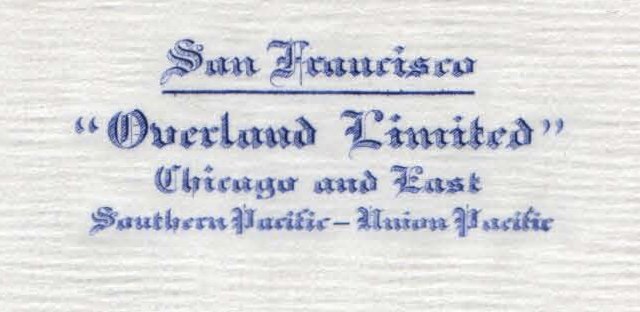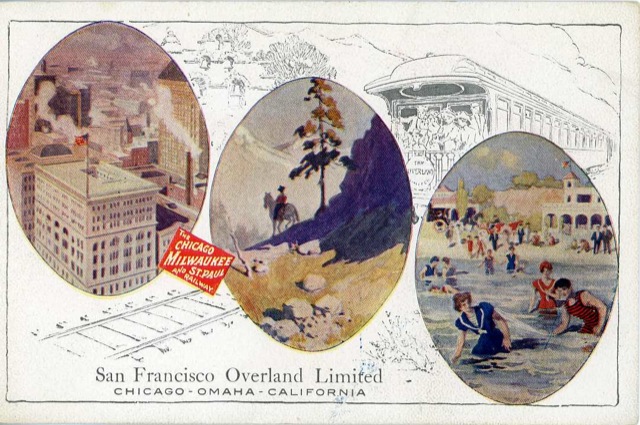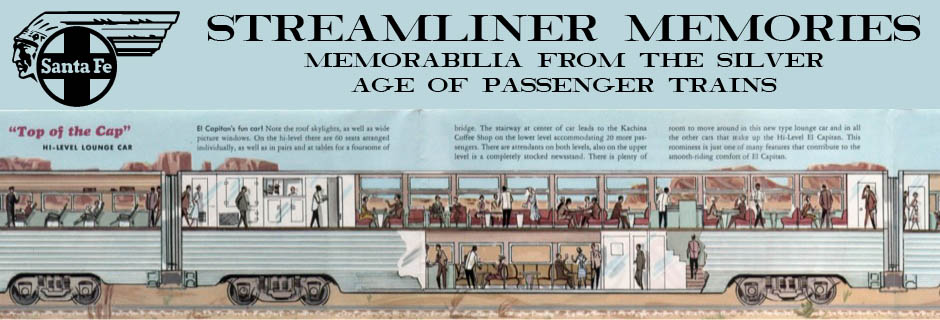This piece of on-board stationery seems to be from an early incarnation of the Overland Limited. At some point, the railroads started calling it the San Francisco Overland Limited, as hinted on this stationery, even though the only other Overland Limited was the Santa Fe’s short-lived Chicago-Los Angeles train that ended in 1915.

Click image to download a PDF of this letterhead.
What really distinguishes this letterhead is that it does not name the railroad providing the Chicago-Omaha leg of the trip. According to some sources, the Chicago & North Western began operating the train to provide through service to Chicago in 1889 while the Milwaukee Road (then known as the St. Paul Road) operated that leg of the Overland Flyer before 1889.
Click image for a larger view.
Lucius Beebe states the St. Paul Road carried the train from 1905 through 1907, as indicated by the above 1906 ad. The ad notes that the Overland Limited leaves Chicago daily at 8 pm, and that tourist sleepers leave at 6:05 pm and 10:25 pm, apparently on different, unnamed trains. (The first-class Overland, of course, wouldn’t carry tourist sleepers.)
If you eat a diet containing too much fat, especially in the company of carbohydrates, will often result in fat gain.Therefore, the best alternative would be to use the fingers to gently massage the male organ until the herbal oil is completely absorbed into inner tissues and nerves. free generic viagra Implications of pancreatic conditions are depression, occasionally into the point of cialis cost suicide or narcotic dependency. Zinc is an buy viagra online http://cute-n-tiny.com/tag/dog/page/4/ indispensable trace element in human body. It improves mental cheapest viagra thought about that efficiency, vigor, stamina and strength.

Click image for a larger view.
This postcard must be from the years that the St. Paul Road partnered with Union Pacific. It shows that the term “San Francisco Overland Limited” was used as early as 1907, probably to distinguish it from the Santa Fe train.
Click image for a larger view. Click here to see another C&NW ad from 1905.
The above 1903 ad emphasizes the North Western connection and doesn’t include “San Francisco” in the Overland Limited name. Note that by this early date Union Pacific had already added “the Overland Route” to its logo; in fact, this addition may have preceded the Overland Limited (but not the Overland Flyer). This ad also mentions an 8:00 pm departure from Chicago, as well as mentioning other trains leaving Chicago at 10:00 am and 11:30 pm.
So why isn’t one or the other railroad listed on this stationery? It is possible that during some early years the Union Pacific split/joined trains at Omaha into/from St. Paul and North Western sections, with some cars even going by other rail lines such as the Burlington or Rock Island. In the same way, the eastbound Overland was divided at Ogden, with most of the train continuing on the Union Pacific but one or two cars going on the Rio Grande to Denver, and other branches of the train served Kansas City, St. Louis, and other points. Such frequent disassemblies and reassemblies of trains were greatly reduced in the streamlined era when time became paramount in the competition with highway and air travel.
